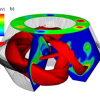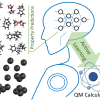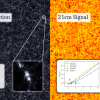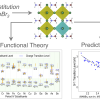Science Vignettes
Cutting Edge Simulations of Lasers Interacting With Dense Plasmas
Intense laser pulses can quickly deposit large amounts of energy into solid materials, thus creating dense plasmas and subjecting matter to extreme temperature and pressure. This is useful in a variety of scientific applications, such as laboratory astrophysics, accelerating particles to high energies over short distances, or generating light pulses lasting just attoseconds. Read More »
Towards Simpler Fusion Power Devices
The ability to model self-organized magnetically confined plasma systems is an important tool for the goal of predictive modeling of devices for design of fusion power systems. This work has expanded the confidence in the modeling of a complicated plasma configuration that imposes large perturbations with a time-dependent 3-D structure. Read More »
Enabling Thermochemistry Estimation using Deep Learning
MIT researchers developed an automated system to continually perform quantum chemistry calculations and use the results to continually retrain a deep learning model for predicting the thermochemistry, i.e., enthalpy of formation, entropy, and heat capacities, of complex polycyclic molecules. A novel approach for estimating uncertainties in these predictions was used to identify which new molecules should be refined with quantum chemistry and added to the training data set. NERSC resources enabled performing many quantum chemistry calculations automatically and in parallel. Read More »
Mapping Neutral Hydrogen in the Early Universe
Researchers at Berkeley Center for Cosmological Physics (BCCP) developed a model that produces maps of the 21cm emission signal from neutral hydrogen in the early universe. Thanks to NERSC supercomputers, the team was able to run simulations with enough dynamic range and fidelity to theoretically explore this uncharted territory which contains 80% of the feasibly observable universe by volume and holds the potential to revolutionize cosmology. Read More »
Machine-Learned Impurity Level Prediction in Semiconductors
Argonne National Laboratory (ANL) researchers ran high-throughout atomistic simulations on NERSC supercomputers and generated comprehensive computational datasets of impurity properties in two classes of semiconductors: lead-based hybrid perovskites and Cd-based chalcogenides. These datasets led to machine learned models which enable accelerated prediction and design for the entire chemical space of materials and impurities in these semiconductor class. Read More »












